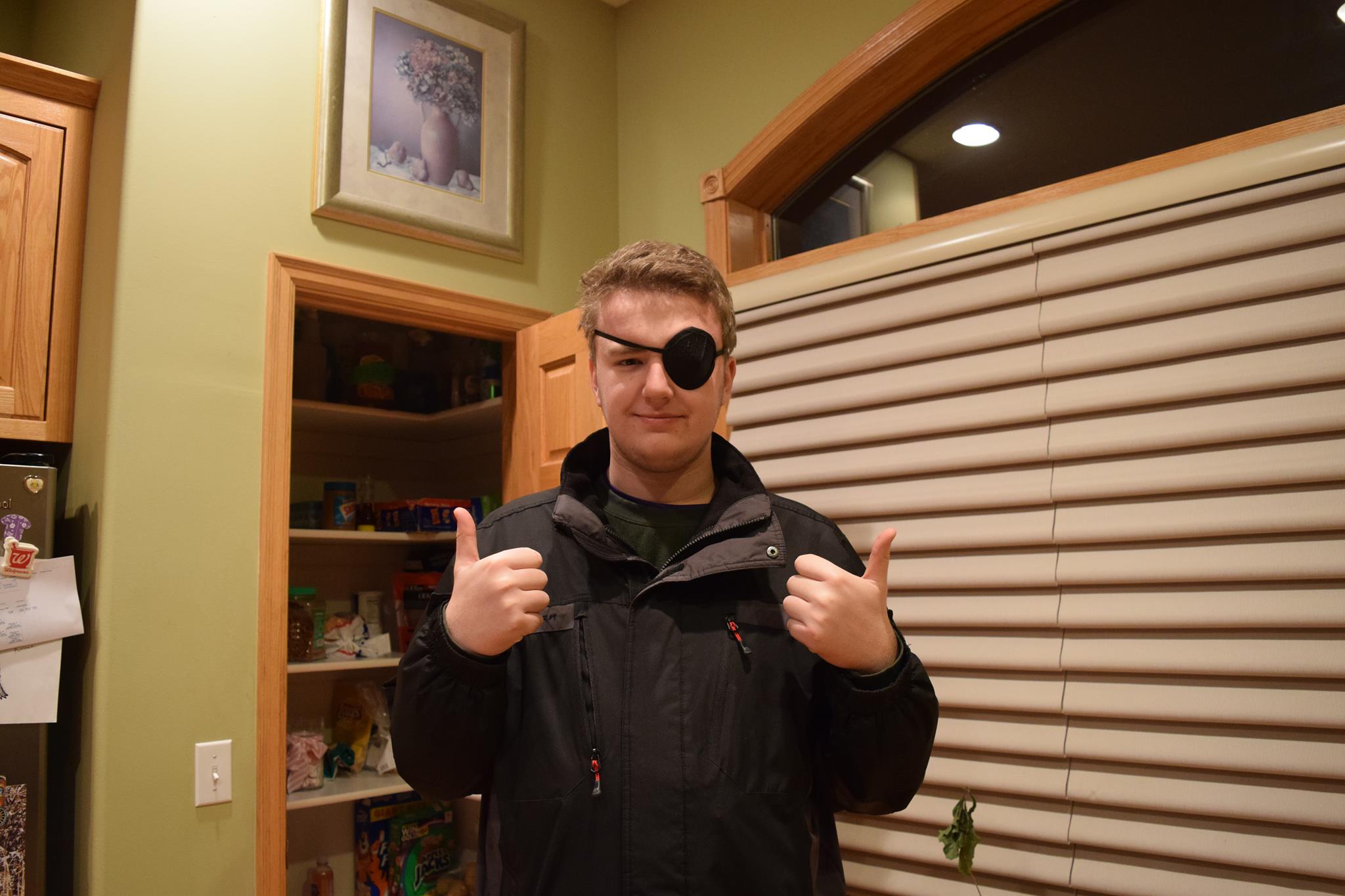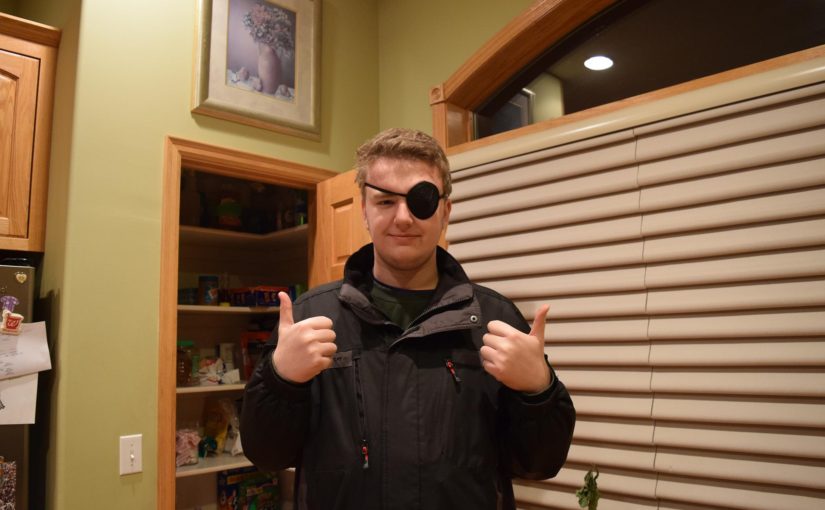
Me, approximately 10 hours after my CXL procedure. Note, you’re not supposed to wear an eye patch after surgery because it can harbor bacteria, but my doctor said I would be alright if I only wore it for a half hour or so.
“Non-corrective” and “blindness” are two words I commonly hear associated with my life’s biggest demon: keratoconus.
The disease is simple yet highly problematic. Basically, normal corneas are formed into a spherical shape such as a basketball, mine however are becoming malformed and turning into an oblong shape, like an American football.
I was lucky to be born into the 0.05 percent of the world’s population who will incur keratoconus in their lifetimes. Keratoconus hampers my vision, essentially allowing me to see almost double of what I’m looking at.
My fears
I, like many of my fellow college-aged cohorts, consume a vast multitude of online video throughout the day.
One of my half-assed life aspirations is to become a filmmaker: producer, director, editor, whatever. I just want to make movies.
I was then told I am facing the potential of being legally blind by the time I’m 40, should nothing be done to prevent the malformation of my corneas.
I don’t have many fears, but I fear wasting the life I have, and I’m afraid going blind might do that. I fear needing to rely on others for help and I fear not being able to fend for myself. I haven’t spoke publicly about it until my writing of this article since I fear thinking about it.
My fears were justified but over-estimated; keratoconus is a treatable ailment.
Ultimately, I decided to write this column to put out a message to others who may incur keratoconus in their lifetimes, as there is little detailed first-person information outside of medical blogs and Reddit forums that I could find.
My diagnosis
Keratoconus is a primarily hereditary disease, passing from one generation to the next in a way that skin color or body size do.
Nobody in my family has a documented case of having keratoconus, though.
I discovered something was wrong with my eyes toward the beginning of summer when I was driving around town and started doing the thing where you close one eye and then the other to see how your vision differs in each eye. Only, this time I noticed my left eye had worse vision than my right and thought I should get it checked out, as my vision with two eyes has been and continues to be nearly perfect.
A visit to my optometrist left him suspecting I may have keratoconus. He recommended me to an ophthalmologist who specializes in keratoconus where my diagnosis was confirmed.
Apparently I was lucky to catch the disease early on, as it can be extremely deteriorating to advanced subjects of the disease.
If you think something is wrong, get it checked. You don’t want to wait and have it be worse than it could have been.
Surgery and post-op
I was basically told by several optometrists and ophthalmologists that I can either have epithelium-off corneal cross linking surgery, also referred to as CXL, or I can hope and pray that I am one of the very few lucky ones that has the disease regress as time goes on and end up not harming me.
Fortunately, I have been lucky to have access to good health care.
The surgery, depending where you get it done, can cost several thousand dollars. The procedure was recently approved by the Food and Drug Administration, meaning that insurance agencies can start covering the costs of the procedure, and I was — to the best of my knowledge — the first person in the entire United States to have the procedure covered by insurance. Sure, a normal deductible was still paid, but it is way cheaper than the several thousand dollars it could have been.
The lead up to eye surgery was arguably the most terrifying thing ever to happen to me in life. Sleepless nights, high stress and living in constant fear something could go wrong and result in blindness.
What happens during CXL? In layman’s terms, a doctor scrapes off an outer part of the eye, a bunch of chemical-infused eye drops get dropped on the eye and then the patient stares at an ultra-violet light for a half hour without blinking or closing their eye. This is done to essentially freeze the corneas in place and prohibit them from becoming more malformed.
It seems awful but really the procedure is not bad at all. The bad part is the recovery; specifically, not being able to see out of one eye for a given period of time.
The pain, so very accurately described by my doctor, is essentially like having a grain of sand trapped underneath a contact lens.
Following the CXL procedure, you will have trouble opening your eye and light will bother the hell out of you for a few days. The pain usually subsides after three to five days. In my case the pain was very tolerable, it was just incredibly annoying.
Eye drops are a pain in the ass throughout the process, too. Presently, I have 14 total doses between five or six different medicinal eye drops every day.
My vision will supposedly remain fluctuating and improper for the next three to six months. As I only recently had the CXL procedure, it is too soon to fully discuss the after effects of it.
Moving forward, there is a 98 percent chance that the CXL procedure will stop my corneas from getting worse, and in the uncommon likelihood I am in the other two percent, I can have the procedure done again.
Final thoughts
Finally, some pro-tips to sum it all up:
1. If you think there is something wrong, get it checked out. Don’t wait around for it to get worse.
2. Keratoconus is becoming a very treatable disease, though not yet a curable one.
3. Costs of procedures for keratoconiacs are going down due to new FDA regulations.
4. Eye surgery sounds absolutely terrifying; I will admit going into it I would have rather broken my arm. In reality, it was quite painless in the procedure and the recovery sucks for a few days, but there is rarely months of physical therapy.
5. Find your zen, be calm and in full control of your body and strong enough to withstand any pain that may occur. It will make the procedure go much smoother.
Editor’s Note: Please feel free to share this article with anyone you may know with keratoconus, I would be more than happy to talk to them about it and answer any questions they may have. They can reach me at caseypatrickmccarty@gmail.com
